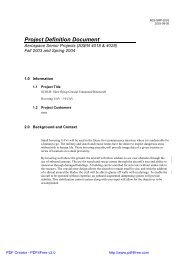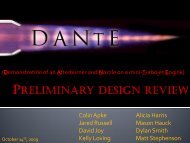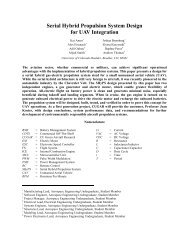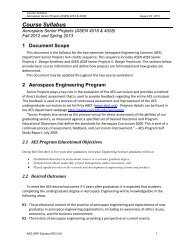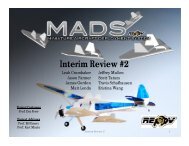PFR - Aerospace Engineering Sciences Senior Design Projects ...
PFR - Aerospace Engineering Sciences Senior Design Projects ...
PFR - Aerospace Engineering Sciences Senior Design Projects ...
Create successful ePaper yourself
Turn your PDF publications into a flip-book with our unique Google optimized e-Paper software.
Project Final Report – CUDBF April 30 th , 2009<br />
ASEN 4028: <strong>Aerospace</strong> <strong>Senior</strong> <strong>Projects</strong><br />
locations, the required whiffle tree configuration was designed as seen in Figure 116, where ∆<br />
corresponds to a distance of 5 inches.<br />
() = −0.001 + 0.0215 + 0.807<br />
Equation 35: Estimated Wing Loading Function<br />
Figure 116: Whiffle Tree Final <strong>Design</strong><br />
The results from the test were then compared to a predicted max tip displacement of 0.62 inches<br />
at 3 g loading, and with a COSMOSWorks FEM model prediction of 0.69 inch max tip<br />
displacement. The COSMOSWorks FEM model and loading analysis are shown in Figure 117.<br />
Figure 117: COSMOSWorks FEM Model of Tip Displacement<br />
The whiffle tree then distributed a single load applied on the bottom rung to model the actual lift<br />
curve along the wing. The whiffle tree system was composed of multiple straps and metal beams<br />
placed onto the wing and taped into place to avoid slippage during testing. Weight was applied<br />
in 5 lb increments to the bottom rung of the whiffle tree to a loading of 3 g’s (22.5 lbs), which<br />
the wing was designed to withstand. The deflection at this point was then measured by using a<br />
ruler to measure the difference between the wing tip and an above the wing beam reference.<br />
This beam reference was a spar mounted above the wing onto the 2”x4” board where<br />
135




